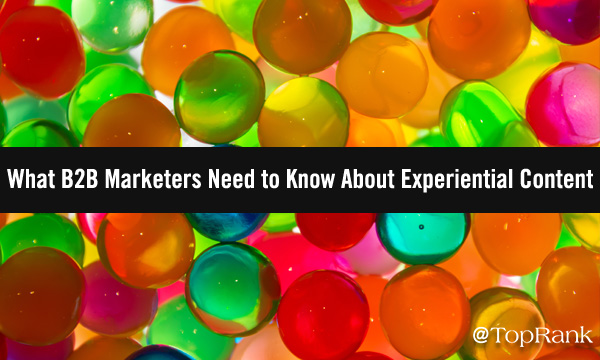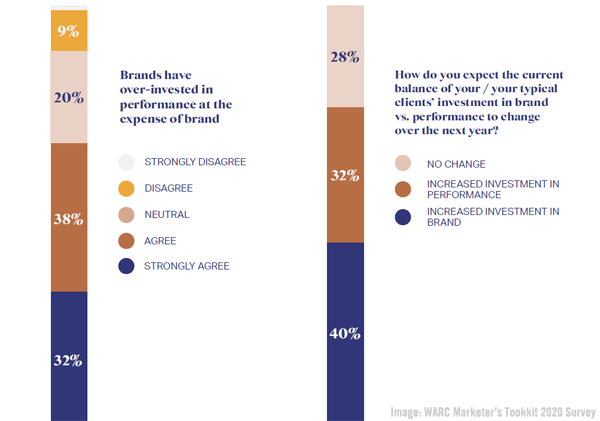
Experiential content will help drive 2020’s digital agenda, and savvy B2B marketers should take notice.
Experiential is a word with subtly differing meanings depending on which setting it’s used in, however at the core of each definition is the fact that it all boils down to experiences.
Experiential content makes us a central part of a story, and not just a passive subject receiving a one-way brand message.

Use of experiential content has grown over the past several years as online technologies have reached a level capable delivering vibrant and engaging motion and sounds alongside clickable, swipable, and all other manner of interactivity to put you front and center.
TopRank Marketing CEO Lee Odden recently mentioned experiential content in his annual list of the top ten B2B digital marketing trends for 2020.
“Visual, experiential content that is easy to find and satisfies business buyer’s needs to be informed, entertained and inspired will continue to be areas of focus.” @LeeOdden Click To Tweet
With 98 percent of consumers more likely to make a purchase after an experience (Limelight), and 77 percent having chosen, recommended, or paid more for a brand that delivers a personalized service or experience (Forrester), why haven’t more B2B marketers begun to use experiential content?
Experiential Content’s Advantages
In a seemingly million-message-a-minute online world, experiential content offers a number of advantages.
It removes us from all other messaging, if only for a short while, and allows us to enter a world under our own control, where we can interact as we see fit, learning or buying at our own pace, all while creating a story that intertwines us with brand information and messaging.
In 2020 experiential content comes in many forms, no longer limited to just the real-world selfie booths and similar elements of the past, with just a few examples listed here:
- Virtual Reality (VR)
- Augmented Reality (AR)
- Cloud-Based Digital Assets from Ceros and Other Platforms
- Quizzes and Polls
- Interactive Flipbooks and eBooks
In a way online gaming has been leading the way for decades when it comes to digital experiential content, and only recently have brands and marketers started to bring this power to B2B advertising campaigns.
An example of experiential content comes in the form of our Break Free of Boring B2B Guide, featuring interactive insight from a variety of B2B marketing industry influencers. Click here to enter the full-screen experience.
Experiential Marketing Embraces Digital Storytelling
Experiential content is also intertwined with both storytelling and customer experience (CX), together forming an extremely powerful triptych of B2B marketing strategy.
As a key component of experiential content, storytelling becomes even more personal and memorable when you’re a key part of the messaging experience a brand is sharing, and being remembered is more important — as well as more difficult — today than ever, which is why forward-thinking B2B marketers are utilizing experiential tactics in their 2020 tool-kits.
The importance of storytelling in the customer journey has become less of a secret in the past five years, as marketing experts and the data to back up the fact have combined to make brand storytelling a trend for the decade ahead.
“Experiential content’s role in powerful storytelling will be an increasing theme among B2B marketers looking to drive next-generation brand efforts.” — Lane R. Ellis @lanerellis Click To Tweet
Experiential Marketing Embraces Great CX
The other key element of experiential content — CX — appears to offer an ideal match, combining to form two important facets of successful B2B marketing.
What better way to deliver a stellar customer experience than by creating memorable brand storytelling using experiential content?
Two years ago we saw the rise of real-world physical pop-ups from the likes of 29Rooms achieving considerable success on Instagram and other social media platforms, however a shift to creating these worlds virtually online as immersive experiential content has taken place in 2019 and into 2020.
Experiential content also appears in WARC’s recently-released ninth-annual marketers report for 2020, which places it alongside purpose and product as three of the most important elements needed for brands to achieve greater success this year.
Some marketers and brands are pulling back from an over-investment in technology that has taken a certain amount of focus away from creativity, the same report’s survey data shows.

Indeed, among the survey’s respondents — almost 800 global client and agency-side executives — one of the top elements comprising experiential content, VR and AR, was seen as being one of the most important emerging technologies in 2020.
Another big part of experiential content is online video, a near-unanimous selection on most top marketing trend lists, as it continues to receive the type of swift growth in ad spend dollars that has helped make online video a big success for Instagram, YouTube, and increasingly TikTok.
Over 80 percent of marketers plan to increase spending for online video in 2020, with 33 percent planning to boost spending on TikTok this year, according to the WARC survey. In the U.S. alone digital video spedning is expected to increase by over 31 percent in 2020, to $5 billion. (Winterberry Group)
“Being creative while retaining consistency of brand is key to unlocking the benefits of brand-building: from forging emotional attachments, to driving long-term brand equity and sales influences.” — Simon Cook @Cannes_Lions Click To Tweet
Cloud-based experiential content platform Ceros offers both an overview guide and an on-demand webinar for learning more about the technology, and offers up their own take on just what the term means.
“Experiential content is digital content that is purposefully designed to create an immersive experience for its consumers through some combination of interactions, animations, embedded media, and storytelling. It encourages active participation in an effort to form memorable, emotional connections between the consumer and the brand or creator,” Ceros notes.
“Experiential content makes us a central part of a story, and not just a passive subject receiving a one-way brand message.” — Lane R. Ellis @lanerellis Click To Tweet
Bake More Experiential Goodness Into Your B2B Efforts For 2020
We’ve looked at what experiential content is, explored a few examples of how B2B brands are using it successfully, and showed how it is likely to see growing adoption in 2020 and beyond.
It takes considerable time, effort, and resources to implement a standout experiential content campaign, which is why many brands turn to a dedicated agency.
TopRank Marketing had the honor of being named by Forrester as the only B2B marketing agency offering influencer marketing as a top capability in its “B2B Marketing Agencies, North America, Q1 2019” report.”
Finally, here are several additional related resources we’ve put together to help you build your own interactive content:
Looking to learn even more about B2B marketing? Tune in to two free upcoming webinars with our CEO Lee Odden, with complete details here.

Comments are Closed